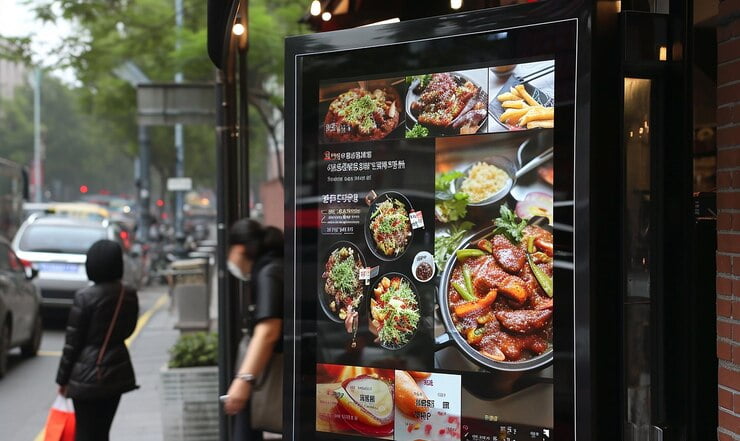Among the continuously changing world in communication and advertising, one of the most innovative and effective media to be uncovered is digital signage. The technology places multimedia content on digital displays and changes the way businesses, institutions, and public places pass their messages to their audiences. From lively retail displays to interactive wayfinding systems, digital menu boards are reshaping our visual environment. This article is a detailed investigation into discussing digital signage, its benefits, applications, and future potential.
The Evolution of Digital Signage
It is a medium that has rapidly evolved in its journey, right from electronic displays. At its early stage, digital signage could only be used to display simple text and images. The current development includes high-definition video, interactive features, and integration with real-time data, all of which give a full and lively visual experience. The high-speed internet and advanced content management systems have further developed so much that the approach is secure and user-friendly.
Advantages of Using Digital Signage
- Dynamic Content Delivery: It provides dynamic content; unlike static signs, a digital menu board can deliver video content and motion graphics with various displays.
- Real-Time Information: Updating information can be done easily because of its flexibility, thereby enabling a business to display real-time information, including news updates, emergency alerts, and promotional offers. In environments where timely communication is quite crucial, this becomes a critical element for a service that can respond accordingly.
- Cost-Effective and Sustainable: Though the costs related to setting up a digital signage system may be relatively high at the beginning, it is rather cost-effective in the long run as it saves money from the installation of printed structures that have to be replaced regularly and also saves money on other resources used in maintaining a printed system due to the traditional use of signage. Furthermore, it supports sustainability by reducing paper waste.
- Better Customer Experience: Digital interactive signages would enhance the customer experience through content personalization, self-service options, and engaging interfaces. This creates an emotional bond with the target audience.
- Data-Driven Insight: Advanced digital menu board systems have the capability to record and analyze data based on viewers’ behavior and engagement. It’s important information in personalizing content and optimizing marketing strategies to better fit the audience’s needs.
Different Uses of Digital Signage
• Retail: The use of digital menu boards in retail can easily influence and persuade shoppers to make decisions. Dynamic advertising can be carried on with such signs, highlighting promotions, or even presenting product information. Allowing customers to have access to products, their location, and stock status using interactive kiosks will help to ensure they get a rich shopping experience.
• Hospitality: Digital signs are used to improve guest experiences in hotels, restaurants, and resorts. In hotels, digital signage can display menus, amenities, and events in lobbies and dining areas. In-room digital menu boards can offer recommendations and other sources of entertainment.
• Corporate: Digital signage in corporate settings enhances internal communication and employee engagement. This can be done with the help of company news, performance metrics, and even event schedules. In addition, systems of digital wayfinding make it easier for guests to navigate within large office complexes with a minimum waste of time.
• Education: Educational institutes use digital signage for campus-wide information. It can distribute important announcements, event information, and emergency alerts. Interactive displays may help students and visitors find their way around and get information on accessing resources.
• Healthcare: A digital menu board in healthcare facilities helps create a better patient experience by providing information related to wait times, appointment schedules, and health education. It could also be used for wayfinding and real-time updates on the availability of services.
• Transportation: Digital signage at airports, train stations, and bus terminals provides timely travel scheduling information and real-time wayfinding support for aiding a traveler around complex transportation hubs.
The Future of Digital Menu Board
The actual future of digital signage, therefore, lies in tight integration and, hence, dependence on emerging technologies such as artificial intelligence and machine learning, which will redefine the entire delivery of content. This is where AI could be employed in analyzing viewer demographics and preferences for delivering hyper-personalized content. ML algorithms could, in turn, optimize the placement and timing of content for maximum effect.
In another regard, the integration of augmented reality and virtual reality with a digital menu board will make it possible to have immersive and interactive experiences. For example, people in retail outlets can try on various clothes or visualize pieces of furniture in their homes by means of digital displays. All these innovations not only enhance the experience but also give insights into consumer behavior.
Another promising development here is the role of digital signage in smart cities. It will update people with real-time information about traffic, weather reports, the availability of public services, and emergency notifications. All this will be integrated to ensure quality urban living and enhance streamlined city management.
Conclusion
Digital signage goes well beyond the static signs that are their modern cousins; it is a dynamic and flexible medium of communication, drastically changing the way in which we relate to the environment. In today’s scenario, the knack of compelling content being pushed across in real time and fully personalized cannot be ignored. With the progress in technology, undoubtedly, newer solutions brought about by the evolution of digital menu boards will meet the changes that happen in both business and consumer needs. Embracing this technology is not just a competitive advantage but a necessary step towards staying relevant in an increasingly digital world.





